CERTIFIED SOUL NUTRITION
Wishing You a Happy Chanukah!
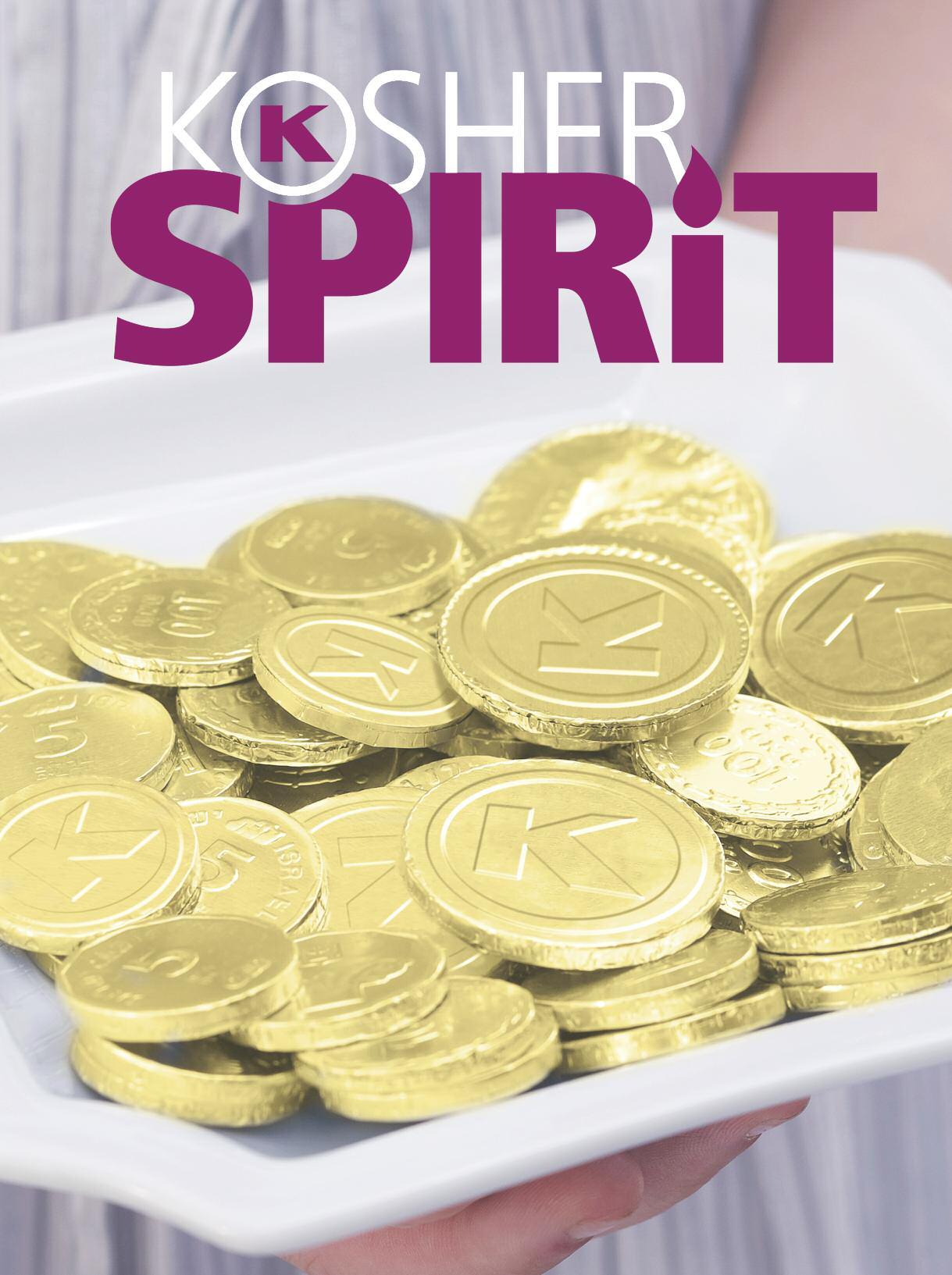
SHARE YOUR SPIRIT

CERTIFIED SOUL NUTRITION
Wishing You a Happy Chanukah!

SHARE YOUR SPIRIT
FOR THE ~ HEALTHY SPIRIT
How Is Your Child Smart?
KEEPING KOSHER IN... GREECE
By Chanie BrodSAVOR THE FLAVOR KASHRUS AND THE FLAVOR INDUSTRY
By Rabbi Elisha RubinWHAT’S SO COMPLICATED ABOUT CHOCOLATE?
By Rabbi Don Yoel LevyANNUAL MASHGIACH CONFERENCE 2012
CHANUKAH RECIPE
Basil Pea Risotto
191 WAYS ~ KOSHERED YOUR WORLD IN 2012
New Companies
WHO’S BEHIND THE ~
Interview with Rabbi Yeshaya Prizant

CHASSIDIC INSIGHTS
THE WISDOM OF THE CHANUKAH LIGHTS
Compiled by Dina Fraenkel
SOUL NUTRITION
KOSHER SPIRIT Chanukah 5773
EDITOR-IN-CHIEF:
Rabbi Chaim Fogelman
EDITOR: Dovi Scheiner
ASSOCIATE EDITOR: Dina Fraenkel
DESIGN & PHOTOGRAPHY: Spotlight Design
While I was home with my family, taking cover from the super Hurricane Sandy, I was surprised to see that the U.S. Postal Service delivered the mail right to my door. I realized the truth of the motto, “Neither snow, nor rain, nor heat, nor gloom of night stays these couriers from the swift completion of their appointed rounds.” Then it dawned on me that while most of us are taking a step back from our daily work schedule, taking a day off or working from home, there are people who can’t and won’t break from their critical and vital work—firefighters, policemen and women, emergency medical technicians and rescue operators all immediately come to mind. Not only are they not stepping back, they are working even harder!
And perhaps in some small way, in the spiritual realm, there is another group of people that get too little recognition for their work in the trenches and doing their job in snow or rain or 50 mile per hour winds—they are the kosher supervisors and mashgichim, without whom a kosher production would not be possible. While the banks and government offices were all closed and the skies dimmed with hurricane clouds, the lights were burning brightly at the ~ headquarters in Brooklyn, New York and our internet servers were at full capacity with office personnel logging in and just doing their jobs.
Perhaps ~ Kosher Certification should adapt the same motto as the U.S. Postal Service:
“Neither snow, nor rain, nor heat, nor gloom of night stays these rabbis from the uncompromising supervision of their appointed kosher productions.”
In this issue you will read about the annual ~ Kosher Mashgichim conference and get to know some of these wonderful rabbis that span the globe just to ensure that the food that is served at your table and mine is kosher without compromise.

Wishing you a Freilichen Chanukah, Rabbi
Chaim Fogelman Editor-in-ChiefI loved reading “Keeping Kosher in Buckingham Palace”. Thank you for sharing this interesting article with us fans of all things royal.
Thank you for the recent Kosher Spirit, it’s very exciting and informative. The picture on page 16 struck a chord with me and I’d like to hang it in my sukkah. I was wondering if you could send it to me by e-mail.
Thank you, YS, Monsey
~ Certified “SportStrings” Tzitzis have been receiving compliments from around the world since their debut last year!

“Super. It’s got a great feel”
A lawyer from New Jersey
“Ari has not taken them off yet. 24 hours and counting.”
Father of a basketball player
“They are amazing.”
Young professional in Cleveland, OH
“I have now been wearing the Sport Strings Tzitzit for a couple weeks. They are very well made, and hold up well and keep pretty cool even under the hot sun here in Afghanistan. I am very pleased! Thank you so much and keep up the great work!!”
David D. Stanton US Contractor—Deployed, Afghanistan“My son absolutely loves the tzizit—he said he is never taking them off except to shower—and he wants to sleep in them. I told him to take them off before bed…turns out he slept in them!!!”
A mother in Teaneck, NJ
“I am the father of Eli. I want to tell you a quick story last night Eli played basketball at our local yeshiva. He used the Sport Strings tzizit which is the first time he wore tzizit while playing basketball. In addition, he normally doesn't wear a yarmulke when he plays. Last night before we went to the Yeshiva, he said, ‘I took clips because I don't think it is right to play basketball in the Yeshiva without wearing a yarmulke.’
There is no doubt in my mind that it is your influence that made him decide to wear a yarmulke.”
A father in Connecticut
The ~ receives many letters/emails with kosher questions...
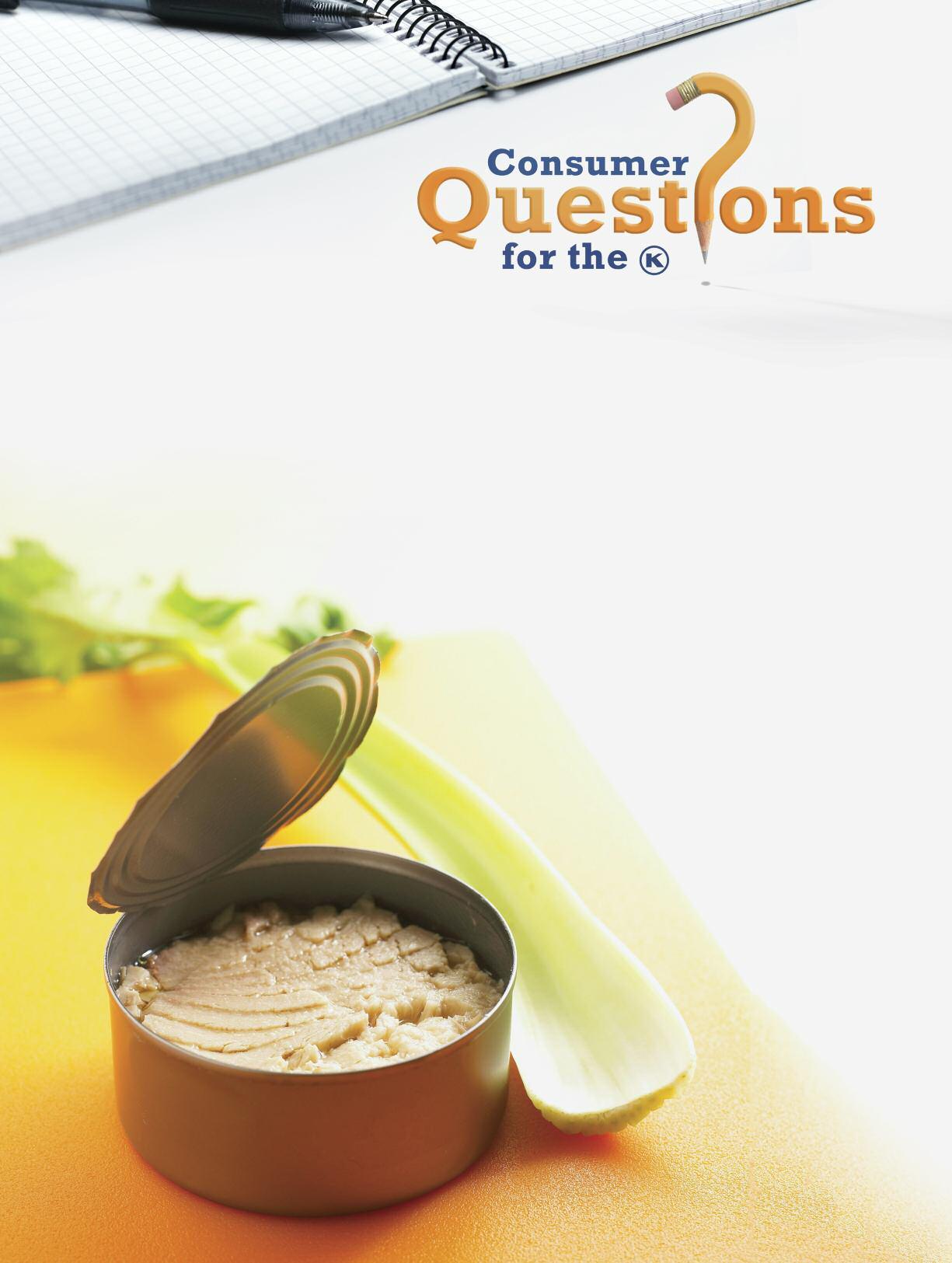
In a previous issue of Kosher Spirit (Tishrei 5768), the article on kosher fish mentioned that not all varieties of tuna are kosher. How is this possible and what varieties are not kosher?
The ~ responds:
Depending on where you are in the world, fish names are surprisingly interchangeable! In one country a certain fish is called “tuna”, while in another country it is called “mackerel”. This is especially common in the “cod” family of fish.
Tuna, mackerel and kingfish are part of the same family of fish species. A specific mackerel, called “snake mackerel” is NOT a kosher fish, but depending on the country, it may be referred to as “mackerel” or “tuna”. In addition, many fish in the tuna, mackerel and kingfish family have scales that fall off as the fish leaves the water, making it very difficult to discern the kosher status of the fish.
Therefore it is important to buy only tuna with a reliable kosher certification and mashgiach temidi.

LINGUISTIC: Sensitivity to the meaning and order of words. Expanded vocabulary and usually like to tell jokes, riddles or puns. They also like to read, write, tell stories and play word games.
Chanukah הכונח has the same root as the word chinuch ךוניח—to educate. Parents and teachers have always known that children learn in different ways. An activity that captivates one child will leave another child uninterested, and a method that reaches one child may lose another. The Torah calls this method “Chanoch le’naar al pi darko. Teach every child according to his way.” Reaching a child according to their individual intelligence and learning style helps the child learn best and reach his or her highest potential.
NATURALIST: Recognizing and classifying the numerous species, the flora and fauna, of an environment. These kids like to spend time outdoors observing plants, collecting rocks and catching insects, and are attuned to relationships in nature.
2 3 4 5
LOGICAL-MATHEMATICAL: These learners enjoy working with numbers, want to know how things work, ask lots of questions, and collect items and keep track of their collections.
BODILY-KINESTHETIC: Kinesthetic learners enjoy sports and love to be physically active. They tend to use body language, dance, act or engage in mime.
1 6 7 8
MUSICAL: Sensitivity to pitch, melody, rhythm and tone. These children love to listen to and play music, sing, hum, move to the rhythm, and create and replicate tunes.
SPATIAL: The ability to perceive the world accurately and to re-create or transform aspects of that world. These learners doodle, paint, draw and build with blocks. They also enjoy looking at maps, doing puzzles and mazes, and taking things apart and putting them back together.
INTERPERSONAL: Understanding people and relationships. These children have many friends and tend to mediate between them and be excellent team players.
INTRAPERSONAL:
The ability to use one’s emotional life as a means to understand oneself and others. Children with this type of intelligence control their own feelings and moods and often observe and listen. They do best when working alone.
The easiest way to discover a child’s learning style is to observe the child at play. Does the child study objects intently, or feel them with the hands? Does the child prefer to exercise his body rather than play with toys? Does the child focus well on a book, prefer the pictures, enjoy the sound of your voice as you read the words? Each prefer-
ence points to another area of intelligence. Most children have multiple intelligences and many children display a preference for a particular style by age 2.
Teaching a child “al pi darko” as our Torah teaches allows for the mastery of new skills while minimizing frustration and developing a lifelong love of learning.
The year was 167 BCE. The place, Judea. Under the leadership of King Antiochus, some forty thousand Syrian Greek soldiers were sharpening their spears and mounting their war elephants. The enemy? The Maccabees, a tiny army of poorly equipped Jewish warriors under the leadership of Mattisyahu. The objective was simple, to eradicate those archaic Jewish practices such as kosher observance and circumcision and replace them with Hellenism—the “enlightened” culture of the Greeks.
Antiochus had little doubt that by the end of the century, the observance of kashrus would have gone in the way of the dinosaurs. Had someone suggested that two millennia later Jews would not only be keeping kosher in Israel, but in Greece itself.... well, chances are that Antiochus would have enjoyed a good laugh at the ludicracy of the notion. And for the one that suggested the treacherous notion? That comment would have cost him his life, but he would have been right.
The Jewish community in Greece is among the oldest Jewish communities still in existence, dating back to the time of the Second BeisHaMikdash.

After the expulsion of the Jews from Spain by Ferdinand and Isabella in the fifteenth century, the small community grew further as many refugees made their way to Greece. Today the country hosts thousands of Jewish tourists each year as they come to enjoy the perfect blend of sandy beaches, mountain views and historical architecture.
Yet despite its rich heritage, there was little organized Judaism available for the small community. In 2001,
Rabbi Mendel Hendel and his wife Nechama moved to Athens, Greece. The couple moved there as Chabad Shluchim with the aim of meeting the spiritual needs of the local Jews. One of the first hurdles they encountered was keeping kosher.
“Keeping kosher in Greece is often difficult,” the Israeli rabbi admits. “It’s a lot less accessible than in cities with larger Jewish populations. We can’t get much more than fruit, vegetables and a few other basics at the local stores. We have most of our food delivered.” At first that sounds like something I may be able to relate to. Rather than being honked at by angry New York drivers and then hunting for that rare parking spot that was neither by a fire hydrant nor a driveway, I, too, choose to order my groceries online and have them delivered. I quickly find out that our deliveries are not all that similar. For a start, while my groceries are from a mile or two away, the Hendels receive their deliveries from an entirely different country.
“We usually order our food from kosher supermarkets in France, Belgium or Italy. As they too are

members of the European Union, transporting the food is often much faster since they don’t have to pass through customs.” He explains. While the weeks leading up to Pesach are not the most relaxing for most families, the Hendels had an extra nerve-wracking couple of days when a shipment from Israel (not a member of the EU) containing matzah , wine and meat for the holiday was treated to an extended stay at Greek Customs. The release date was indefinite despite Passover’s date rapidly approaching. “Thank G-d, we received it just a few days before the holiday,” he exhales at the memory. In recent years the size of the deliveries increased dramatically. No longer were the groceries being ordered exclusively for the Hendel family and their many guests. Instead, Chabad of Athens opened a kosher mini market to make kosher food available to the wider community and many tourists. Rabbi Hendel explains what triggered the opening of the mini market.
“People were learning about kashrus in our Torah classes. They understood the beauty and significance of this core mitzvah and they wanted to put what they had learned into practice. But kosher food was not easily accessible, I can promise you that.” Rabbi Hendel recalls. “We saw that we had to provide them with more than just the knowledge about kashrus. We had to make keeping kosher accessible for the Jews of Athens.” Foregoing steak and cheese and subsiding on beans and rice was hardly an appealing
prospect for those considering adopting the laws of kashrus, and so the mini market was opened. For the Jewish residents and tourists of Athens, keeping kosher meant sacrificing the option of dining out. There were no kosher restaurants where one could enjoy gourmet cuisine in celebration of a birthday, anniversary, or just because. There was nowhere to order dinner from on the rare occasion that one was too tired to cook themselves. And for the many tourists, there was nowhere to enjoy a hot meal. But all that changed last year with the opening of Greece’s first and only kosher restaurant, an elegant Sephardic diner called Gostijo.
Friday nights it hosts Shabbat dinners. Other times it hosts kosher cooking classes or musical evenings. “The restaurant is much more than a place to eat,” agrees Rabbi Hendel. “It is a place where we celebrate our rich Jewish culture and heritage.”
2000 years after Antiochus penalized the observance of kosher with death, Judaism is thriving in Greece. Unfortunately Greece itself is going through one of its roughest patches in history and its own rich heritage is being violated. Today Greece is synonymous with a failed economy as unemployment affects 25% of its citizens. Zalman, a young man who recently visited Athens, describes his impres-
spread the light of Chanukah throughout Greece. Several years ago, Rabbi Mendel and Nechama set out on a mission: to equip as many Jews as possible with the tools to light the Chanukah menorah.
“We spent days and days in the car with maps and the GPS, which proved not to be always reliable.” writes Nechama. “One time we were in Lykavettos, a very hilly area, and the authoritative voice of the GPS tells us: ‘Turn left”… onto some stairs! We continued and she urged us: ‘Turn left NOW!’ and after we passed it we heard the dreaded: ‘You are now off track!’.
“It was a highlight of our visit to Athens,” Erica, a native New Yorker, enthused of her recent visit to Gostijo. “The chef produces such delightful food and the hosts are warm and welcoming, with such interesting backgrounds. Nechama speaks four languages, all with a native accent and idiomatically correct! The Hendels could not be more charming.” But Gostijo is more than just a place to sample exotic Mediterranean dishes such as Mujadera or Poyopatata. As well as catering all types of events, on
sions of the city. “It was not pretty. The city itself is beautiful with magnificent architecture and amazing history. But now there was graffiti everywhere, desecrating historical landmarks.... The people are going through a rough time. There were constant protests, police out in riot gear...It was a rather depressing scene.”
As Greece struggles to overcome one of their darkest times, the light of Chanukah is even more poignant. In her blog “It’s all Greek to Me!” (chabad.gr/blog), Nechama Hendel describes how their campaign to
Despite the difficulty involved, the effort was much appreciated by the grateful recipients. After finding a menorah and candles on his doorstep, one delighted gentleman called the Hendels the next day. “How did you know?” He asked in wonder. “Just yesterday morning my wife and I were discussing how we would love to light Chanukah candles, but we had no idea where to find them. And that same evening you bring them to our door!”
Now dozens of volunteers join the couple in spreading the light of Chanukah by delivering the kits.
The year is 2012. The place, Athens. As the city struggles through one of its darkest times in history, a small group of Jews gather in the city center. Their mission is simple, to share the light and joy of Chanukah with the hurting city. And so they sing and dance and enjoy kosher jelly doughnuts, and then the streets become a bit brighter as the flames of the menorah dance in Athens.
The Jewish community in Greece is among the oldest Jewish communities still in existence, dating back to the time of the Second BeisHaMikdash...

 BY RABBI ELISHA RUBIN
BY RABBI ELISHA RUBIN
One of the perks of working in kashrus is that we get to see the food we eat being made and the processes involved. The processes can be rather interesting, but it does not always lead to better appetite! As the Gemara in Sanhedrin (39a) says Antinonus asked Rabbi, “Why did Hashem have to put Adom to sleep when He took out the rib to create Chava? Was He trying to steal something and therefore had to take it in a sneaky manner?” To answer, Rabbi took him to watch the slaughtering and butchering process and showed him how watching the process took away his appetite for an otherwise tasty piece of meat. (Unfortunately, I still haven’t managed to lose much weight.) Flavor companies are a prime example of a fascinating industry, from both perspectives — kashrus and production (with sometimes not so appetizing processes).
and artificial” (N&A) instead of just artificial. This information is very important because now you can understand why a natural cheese flavor can be pareve, or conversely a natural orange flavor can easily be dairy or a natural cherry flavor can be nonkosher.

Certifying modern food production facilities is not just about walking in and looking around. In many factories, the kosher complexities are often hidden from view and not at all obvious. It takes an understanding of the technology and production methods employed in the factories to provide proper kosher certification.
ing tanks. The workers in the flavors house (compounders) just mix the flavors together following a recipe, without any complicated processes or technology.
To create a flavor, the flavorists test many combinations and amounts of chemicals to find the ideal recipe. After rigorous testing, a recipe is finalized (that’s why there are so many different kinds of vanilla flavored ice cream, for example). While there is complex chemistry involved in the creation of the flavor chemicals (some chemicals carry the skull and bones insignia on them and if more than the correct amount is mixed into a recipe,
Growing up, like most people, I thought “natural flavors” were actually squeezed out of the relevant fruit, meaning “blueberry flavor” was squeezed out of a blueberry and only artificial flavors came from chemicals. In reality, natural flavors are made from bottles of chemicals just like artificial flavors are made from synthetic chemicals. The only difference is that the chemicals for natural flavors are derived from natural materials rather than from synthetic sources, like petroleum, coal, gas or minerals. (In the US, even if the item undergoes synthetic chemical processing, it is still considered natural as long as all the ingredients used were natural. In the European Union, they require that only natural process, such as fermentation, can be used to produce natural flavors.)
Sometimes, natural ingredients are added that actually have almost no practical effect on the flavor (such as fruit juices), but when added the company can label the flavor as “natural

Flavor production facilities, also known as “flavor houses”, are especially complex. A flavor house produces the flavorings that are used in commercial products. For example, lemon iced tea contains a lemon flavor that is created by a flavor company and then is used as an ingredient by the iced tea company. At first, flavor companies can sound scary and foreboding with ingredients like methyl cyclopentolene, 2,6 Decadeinal, 3,6 methyl heptylpryazine, etc., which are very foreign to the average mashgiach or consumer. In reality, while the ingredients used in flavor production are often confusing or foreign, the approval and certification of those ingredients can be quite complex and requires special knowledge of chemical processes. This will IY”H be discussed in a future article. The actual technology for making a flavor in a flavor house is deceptively simple. A flavor house contains many shelves and racks of bottles and drums with different chemicals in each, along with mix-
it could be poisonous), the design of the flavors (the actual recipe) is a process of mixing tastes (called notes) and is actually more of an art than a science.
It is expected that the ingredient approval department will have a challenge determining how each ingredient is made and which can be approved or must be rejected, but that is done in the central ~ office, not on the factory floor. On the floor, the mashgiach should have it easy; if all the ingredients have been vetted by the Ingredient Approval Department at the ~, and added to the mashgiach’s list of ingredients permitted in the facility then you might think there are no problems. Well, it’s not that simple. A typical flavor facility has thousands of ingredients with unfamiliar and confusing names. No one inspecting a bakery is going to confuse shortening and flour – they don’t even look remotely similar. Nor is one likely to confuse Bunge Shortening with Cargill- Magic Chef shortening. But in
In reality, natural flavors are made from bottles of chemicals just like artificial flavors are made from synthetic chemicals...
a flavor company you can have (almost) identical bottles – one containing Geranyl Acetate (innocuous from a kashrus standpoint) and one holding Geranyl Caproate (very kosher sensitive). Additionally, a typical flavor facility will have around 3,000 ingredients. The ~ currently certifies a flavor house with close to 8000 ingredients and checking the thousands of bottles on the shelves is not an easy task. It takes extremely serious attention to detail to keep track of all the ingredients. While many of these ingredients are readily available as kosher, it is common for a flavor facility to have both kosher and nonkosher versions of an ingredient on the shelves, requiring much diligence on the part of the mashgiach
Also challenging, the end products are similar. A company can have hundreds, or even thousands, of varieties of each kind of flavor. Asking a flavor company for a “cherry flavor” is like asking an Englishman for tea or a supermarket for food. There are too many varieties for the name “cherry flavor” to mean anything and the only distinguishing factor is the flavor number. One mushroom flavor can be kosher while another can contain castoreum (beaver extract). Only by paying careful attention to every single detail, including the precise flavor name and number, can we be sure of the kashrus status.
Aside from the obvious attention to detail, a flavor house mashgiach needs a thorough understanding of the production process. In order for something to be kosher, in addition to its ingredients being kosher, the equipment it is processed on needs to be kosher. Of the three thousand ingredients in a typical flavor house, it is rare that all will be kosher. Therefore a part of the certification process will be to make sure that kosher products are only made on kosher equipment. As we discussed, flavor blending is typically simple blending of different ingredients with different flavors. There is no cooking in the process and there-
fore no heat should be needed. In fact, flavor companies want to avoid using heat as much as possible to prevent the evaporation of volatile chemicals which would be a health and quality concern.
Sometimes, heat must be employed to blend various ingredients into a final product. The degree of heat involved can have an impact on the kosher status of the utensils and equipment. Yad Soledes Bo is the halachic term for heating a liquid to a temperature that a person cannot bear to touch with a bare hand. If a liquid is heated to this temperature, it can change the kosher status of the equipment or utensil used and requires a specific kosherization process to return it to its prior state. If a liquid is heated below this temperature, it is possible to avoid kashrus complications, as long as the equipment is cleaned adequately. Due to the powerful nature of the ingredients used, flavor companies thoroughly clean the equipment to avoid cross contamination and other healthy and quality issues. There are areas though where heat may be used above YadSoledes Bo and the mashgiach needs to be aware of those situations due to the kashrus implications.
The following are some of the typical production processes that will be employed in a flavor company. In larger companies, each of these will be done in their own separate facility, but in smaller companies all of these processes often occur in the same building.
TYPICAL
PROCESSES:
The vast majority of sweet flavors are made by cold blending. The process is as simple as it sounds. Flavors chemicals are poured out into tanks and mixed to create the desired flavor. But, even “cold” blending sometimes needs some heat in the process.
Liquid flavors are typically made by mixing the active ingredients into a base solvent. The most common bases are PG (Propylene Glycol) and Etoh (Ethyl Alcohol). Other bases, such as MCT (Medium Chain Triglycerides) and oils are also used.

Many flavor ingredients are powders and in order to dissolve them in a liquid base heat is often required. Examples of this are Methyl Cyclo Pentalone (MCP), acetoin, ethyl vanillin or vanillin in PG (when mixed with Etoh they do not require heat). It is possible that the company will use heat below Yad Soledes Bo and just mix for a longer period of time, but this needs verification by the mashgiach. Some common flavor ingredients, such as capric acid, dimethyl anthranylate (used in every grape flavor), and AMF (Anhydrous Milk Fat = Concentrated Butter) are solid at room temperature and need to be heated to be poured into a mix. There are a number of common ways they can be heated – storing in a hot room or box, heated in a hot water bath, heated with a heating belt/drum warmer (an electrically heated belt that is wrapped around the drum to warm it up), or heating in a standard production kettle. Obviously, we need to make sure that kosher and nonkosher (or parve and dairy) are not heated on the same equipment in a manner that compromises the kosher integrity of the equipment.
Animal fat is not commonly used in liquid flavors, but would be used in dry blends and would need to be heated to melt. If dry blends are made in the same facility, they could share the same melting equipment and compromise the kosher status of the equipment.
Dry blends are typically exactly what they sound like. Dry powders are mixed together, typically with a ribbon blender (a large open container with a “curled ribbon”, or corkscrew, shaped blending mechanism that runs down the center), but there are multiple ways to mix dry powders. I have even seen a facility where they put the powders in a drum and then roll the drum around on the floor. For the most part, this blending is done dry and cold, but here too there are a few potential complications. Sometimes, liquids are added to these blends. Typically it is done in a process called, “plating”, where the liquids are poured over an absorbent powder, such as salt, and mixed in before adding the other dry ingredients. Sometimes these “liquid” ingredients might require heating in order to become liquid enough to pour and spread. If the same equipment were used with kosher and nonkosher hot liquids it would create a kashrus problem.
EMULSIONS:

Emulsions are made by mixing a starch into a water and flavor mixture to create a stable blend. Many starches require heating to “activate” and start absorbing. Some special “pre-gelatanized” starches will swell even in cold water.
Spray drying is a process that converts a liquid into a powder. Many flavors will be spray dried because powders are easier to store and can be safer to work with than their liquid counterparts.
Spray drying is done in a Spray Dryer. Spray dryers are interesting pieces of equipment. A typical spray dryer can be up to two to four stories tall and approximately 10 to 21 feet in diameter (though a pilot dryer can be as small as 6 feet tall and three feet in diameter).
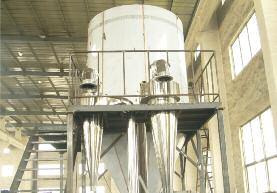
Spray drying is a multi-step process. First the product is mixed together
dry machine, including koshering all hoses and utensils. The koshering process is done with boiling water heated above boiling temperature to ensure that all surfaces, inside and outside, reach boiling temperature.
Sweet flavors are produced through liquid cold blending. There are also savory flavors (used for meat or similar product flavorings), which are frequently produced by reactions.
with a carrier, usually a starch, in an emulsion tank. The mixture is then heated to create an emulsion. The dryer is heated to around 400˚ F (the exact temperature depends on the product being dried), The emulsion is then pumped up to the top of the spray dryer and through a nozzle, usually an atomizer which rotates at high speed, to disperse the product down into the dryer (some dryers use high pressure nozzles that do not rotate).
The product then dries as it drops to the bottom of the dryer, sometimes hitting the walls of the dryer as it drops down. The product then goes up and down in various pipes and bends, called cyclones, to concentrate the product and cool it down.
As one might realize from the preceding description, spray dryers are very expensive pieces of equipment. While the ~ has convinced some facilities to actually dedicate a spray dryer to only kosher pareve production, this is uncommon because the cost of the equipment is prohibitive to such restricted use.
Spray dryers are very difficult to kasher because of their size and the way they operate. The ~ has a complex koshering protocol in place to ensure the kosher status of all spray dryers used for kosher production. The spray dryer must be eino ben yomo (not used for 24 hours) and the mashgiach is given detailed instructions on how to kasher the entire spray
Reactions are made by reacting amino acids and sugars under intense heat and pressure to create new, unique flavors with the ingredients used to make the blend (as opposed to the liquid blending described above that is just a combination of the flavors of the components). Theoretically only ingredients that are easily available as kosher could be used in these products. However, sometimes companies want to have a natural image, so frequently some of the actual product flavor they are trying to imitate is used. For example, some pork is added to the mixture so that the company can say “Natural & Artificial Ham Flavor” even though the natural ham plays no real role in the taste of the flavor. This of course would render the flavor and the equipment not kosher.
The ramifications of this are:
If a formula contains amino acids and sugars, it will need to be heated. Proper controls need to be in place to prevent non-kosher flavors from being made on the same equipment as kosher flavors without proper kosherizing procedures.
The heating of Vanillin in PG (as described previously) can take place on the same equipment as non-kosher formulations, so care must be taken to ensure proper kosherization.
As many readers are aware, there was a controversy in the world of chocolate production over the summer and many brands of pareve chocolate chips became dairy. Most notably, the famous Trader Joe’s chips under the supervision of the ~ had a status change from kosher pareve , to kosher dairy. In light of the intense focus on chocolate production and the many kashrus implications involved, I spoke at length about the general process of chocolate production and kosher certification process at our recent Mashgiach Conference.
Chocolate production begins in Africa and Central America where the pods of cocoa beans are hand cut from trees, split open and the beans removed. The beans are then fermented by laying them in a sunny field and covering the beans with banana leaves. The beans ferment and turn brown after about 5-8 days. The fermentation process is not an issue for Pesach because no yeast is used in the fermentation process. It is a natural process
that occurs inside the actual bean. After fermentation, the beans are transported to factories throughout the world for the actual production.
Once the fermented cocoa beans reach the factory they are roasted with the shells still attached and then winnowed into small bits called nibs. The nibs are then heated and melted into chocolate liquor. The liquor can be pressed and separated into cocoa butter and cocoa powder, or it can be kept
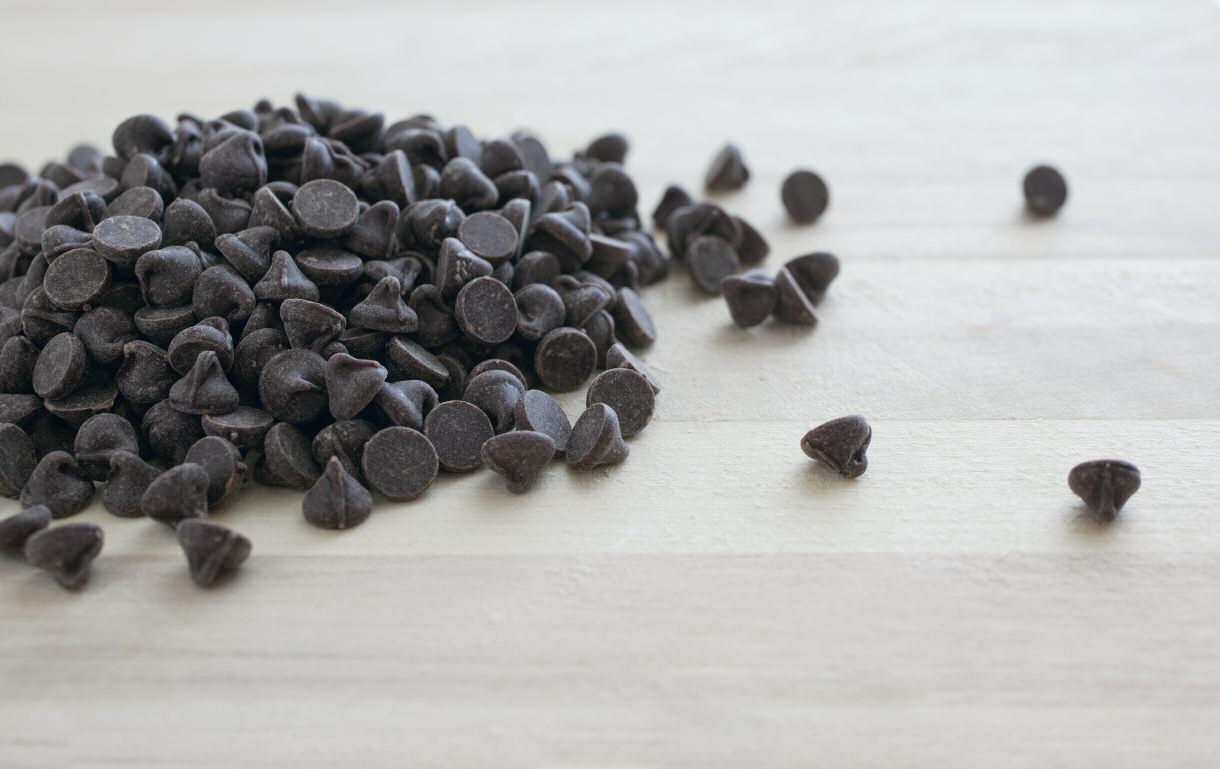
gets into the actual chocolate it ruins the production and causes the chocolate to inflate like fudge. In addition, it can introduce bacteria into the chocolate which is obviously a quality concern. At ~ certified factories that want to use the same mixer for dairy and pareve chocolate, we add a control to the machine to prevent the chocolate mixture from reaching the temperature of Yad Soledes Bo (too hot to touch with the hand). Of course, the mixer is thoroughly cleaned out before pareve productions.
After the blending stage, the chocolate mixture goes through a series of five rollers. The center roller can reach 60 degrees Celsius, which means the roller requires kashering between dairy and pareve. During the conch stage, the chocolate is mixed for over 24 hours. The liquid gets quite hot,
A series of calculations, based on the temperature of the fire and the thickness of the walls of the machine, are made to determine the amount of time needed to complete the libbun. Due to the complexity of kashering chocolate equipment between dairy and pareve, the ~ encourages the use of separate lines for dairy and pareve productions. In fact, we implemented this standard about 35 years ago!
Sometimes, a chocolate production does not turn out well and the chocolate is recycled, called “rework”, and run through the entire production process again. It is very important to ensure that dairy “rework” does not end up reprocessed on a pareve production line.
Once the chocolate production is complete, it is often stored in liquid form in tanks and shipped to other
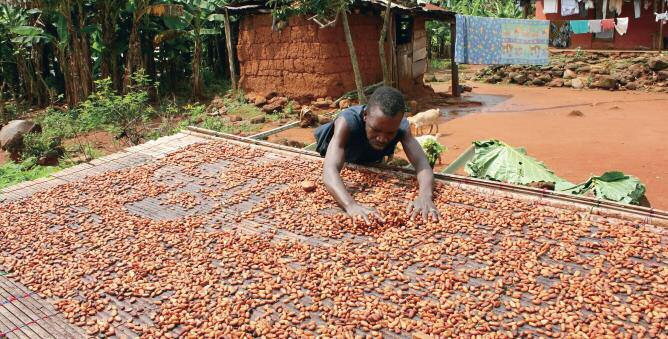


col and stop thoroughly cleaning out the machine between dairy and pareve packaging runs. Unfortunately, the new method does not ensure that no dairy chocolate chips are left in the packaging machine. As a result, every bag of previously pareve chocolate chips has a high probability of being contaminated with actual dairy chocolate chips. Therefore, the kosher designation on this well-known brand was changed from pareve to dairy.
As you can see, even a seemingly simple product with few ingredients can present a wide array of kashrus concerns. Even the simple pleasure of a chocolate bar requires diligent kosher supervision from beginning to end. When you enjoy your homemade chocolate chip cookie for dessert on Shabbos afternoon, or a few squares of dark chocolate on Pesach, you want to
Some people are under the mistaken impression that cocoa butter is dairy, but it is in fact pareve...
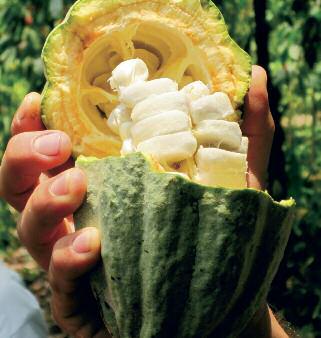
in liquid form. Some people are under the mistaken impression that cocoa butter is dairy, but it is in fact pareve. It is only called “butter” as a description of the consistency, much like shea butter and coconut butter.
In order to make chocolate, the cocoa liquor (or butter or powder) is blended with sugar and lethicin. Starch can also be introduced into the mix, which can be an issue for Pesach since the starch is either chometz or kitniyos. The mixer is heated to maintain the liquidity of the chocolate. The mixer itself is one of the biggest potential kashrus concerns in the chocolate production. Many, if not most, chocolate factories produce both pareve and dairy products and want to use the same equipment for both. The typical and accepted way to kasher a pot (mixer in this case) is by hagola (boiling over with water). Companies are very reluctant to bring water into a chocolate factory because if any water
with dark chocolate reaching a higher temperature than milk chocolate, above the temperature of Yad Soledes Bo
Since it is rare that a company will agree to kasher by hagola we have to kasher by libbun (burning with fire) which is much more difficult. The machinery often has many layers and very thick walls, so it is difficult to discern how long the fire must be lit under the machine in order to kasher by libbun
factories for molding, wrapping and packaging. As discussed in previous articles, bulk liquid transport has a host of kosher requirements. In addition, during the wrapping and packaging process it is vital to be sure that dairy chocolate does not mistakenly end up in packages of pareve chocolate. This actual scenario happened with a well-known brand of chocolate chips this summer. The company decided to change the packaging proto-
be sure that the highest standards were upheld and not one tiny dairy chocolate chip entered your bag of pareve chocolate chips, and not the slightest bit of chometz was in the factory that created your delicious kosher for Pesach chocolate bar. As you bite into a chocolate coin this Chanukah just remember, we are what we eat and we should only accept the best for ourselves and our families – kosher without compromise.









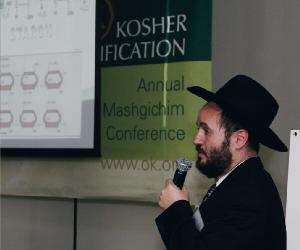




On 27 Mar-Cheshvan (November 12), we held our annual Mashgiach Conference at the Jewish Children’s Museum in Brooklyn, NY. Over 150 ~ personnel and mashgichim were in attendance, including many from around the world.
The ~ honored two outstanding mashgichim Rabbi Favish Moster and Rabbi Yehudah Pink Both rabbis were chosen for their dedication to


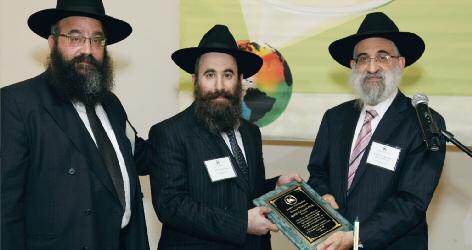
upholding the rigorous kashrus standards set forth by the ~ and the sheer volume of work they do on behalf of the ~ In addition, the ~ honored two of their Rabbinic Coordinators from the Israeli office — Rabbi Shmuel Levi and Rabbi Yeshaya Prizant , as well as the liaison between ~ Headquarters and ~ Israel, Rabbi Moshe Fox, for their dedication and exceptional work.
The ~ also honored ConAgra Foods, a company who is making strides in increasing their kosher offerings, goes out of their way to uphold the highest kashrus standards, and works well with their mashgichim and rabbis. ConAgra Foods, makers
of Hunt’s ketchup, Wesson oil, Pam cooking spray, and countless other kosher products was represented by longtime employees and kosher liaisons Mr. Britt Nichols and Ms. Patty Harvey who were on hand to accept the award on behalf of ConAgra Foods.
In addition, the ~ celebrated our longtime relationship with Mr. Willy Geeraerts, who is soon to retire from Barry Callebaut Chocolate the premier producer of kosher chocolate.
Rabbi Levy Kashrus Administrator, opened the conference with words of Torah and chizuk and a fascinating explanation of kosher chocolate pro-


duction which has been transcribed in this issue of Kosher Spirit Other speakers included noted lecturer Rabbi Yossi Jacobson Rabbi Saul Emanuel Executive Director of Montreal Kosher, Rabbi Ahron Haskel of ~ Israel, and ~ Rabbinic Coordinators Rabbi Yitzchak Hanoka and Rabbi Yitzchak Gornish. Rabbi Levy was also presented with Hakaras HaTov awards from three camps whose campers benefit greatly from his generous camp scholarship program.

The conference ended with a lavish buffet lunch allowing the rabbis to interact with each other and ~ personnel.
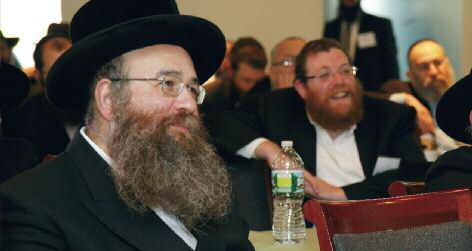
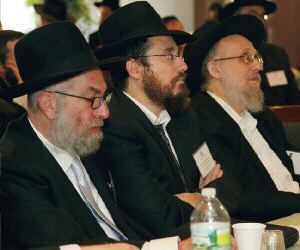


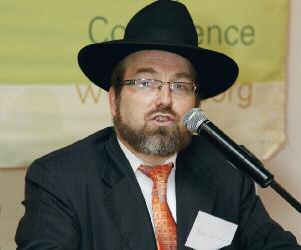

1 cup basil divided (½ cup basil chopped +1/4 cup basil chopped)
2 ½ cups frozen peas (divided into 2 + ½ cup)
3 tablespoons butter
1 tablespoon of oil
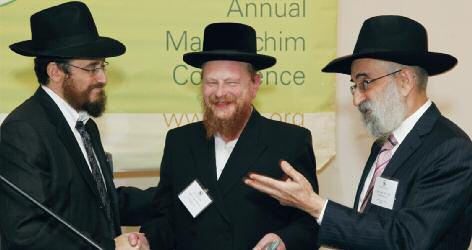





1 shallot




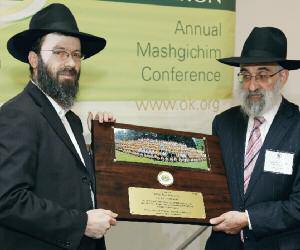




1 clove garlic
1 cup Arborio rice
1 cup of room temperature white wine
3-4 cups vegetable stock
½ cup shredded parmesan cheese
servings: 4-6
Risotto is slow cooked Arborio rice, a very popular Italian dish that is featured on many menus in restaurants all over the world. The starch in the rice releases during cooking and makes a naturally creamy rich dish. It does take a while to prepare, so if you have time and patience and want to bring the restaurant experience to your kitchen, try out this delicious risotto. The risotto is great served with pan seared fish.
1. Place 3/4 cup chopped basil and 2 cups peas in boiling water for three minutes, strain. Place mixture in a bowl and add a tablespoon of butter, sprinkle with salt and pepper and puree with immersion blender (or a regular blender), set aside.
2. Place stock in a pot and bring to a simmer. Keep stock hot during the entire cooking process.
3. As vegetable stock is simmering, melt butter and oil in a large sauté pan and sauté shallot and garlic until shallots are translucent.
4. Add rice, stir rice with butter and onion for about five to seven minutes until rice absorbs butter and rice becomes translucent.
5. Add wine, bring to a simmer and let the wine cook out, constantly stirring rice mixture.
6. Add 1 cup of stock and simmer on low, constantly stirring rice mixture, until liquid is absorbed.
7. Add 1 cup more stock and simmer until liquid is absorbed. Continue to stir the mixture.
8. Add last cup of stock and simmer until all liquid is absorbed.
9. Taste rice. Add salt to taste. If rice is too al dente, add a bit more stock as necessary and simmer until all liquid is absorbed.
10. Once rice is fully cooked, gently stir the basil-pea puree with risotto and mix until combined.
11. Add parmesan cheese, ½ cup reserved peas and 1/4 cup chopped basil to the risotto and serve immediately.
KS: Where did you grow up? Where did you go to yeshiva?
RYP: I was born in Eretz Yisroel in Kiryat Sanz, Netanya. The home of my wonderful parents ט’’יואל ’יש was the best atmosphere for both physical and spiritual growth. When I was 7, shortly after my parents became his mechutonim, the Klausenburger Rebbe zt”l instructed our family to move to Tzfat, where he was determined to reestablish a kehilla and revive the Divrei Chaim’s Beis HaMedrash. I spent the rest of my childhood in Tzfat. I remember how as a boy I walked in the ancient streets thinking of the great tzaddikim, such as the Ari Hakadosh, the Beit Yosef, the Ramak and many other tzadikkimzt”l, who used to walk through the these streets. As a bochur, I travelled back to YeshivatSanz in Netanya, where I spent most of my best years studying and advancing in Torah and halichos chaim.
KS: What did you do after yeshiva?
RYP: At PerekHa’Ish Me’kadesh I was married to my wife Esther ’יחת from Brooklyn, NY and we lived near my wonderful in-laws. I then began halacha studies in Kolel Sanz in Boro Park. After my family grew I had to start working, and by a wonderful Hashgocha Protis I decided to improve my knowledge of electricity, concentrating on Industrial Heating/Cooling systems and engineering, and worked in this field for quite a few years.
KS: What is your current position at the ~?
RYP: I am currently the Rabbinic Coordinator of the China Department at ~ Israel.
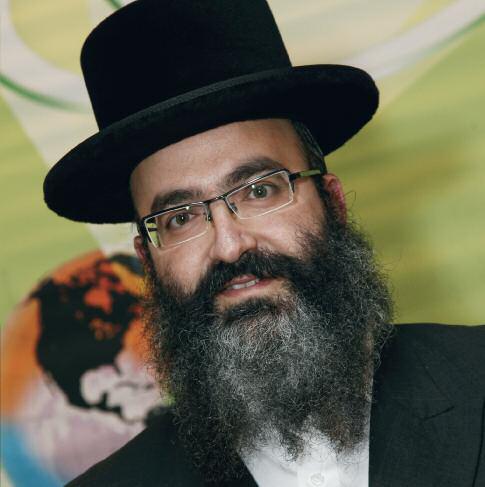
KS: What prepared you the most for your current position at the ~?
RYP: “MeHashem mitzadei gever konenu. The steps of man are ordered by Hashem.” (Psalms 37, 23) is the verse that comes to mind. The combination of my halacha studies and my engineering work was exactly what led me to work in the kashrus field, and later, to my current position. As anyone who knows something about how kosher works, inspecting facilities requires a great deal of halachic knowledge as well as a great deal of technical knowledge to understand the heating systems, steam systems, etc. I am fortunate to have such helpful background skills.
KS: What is best thing about working at the ~?
RYP: There are many possible answers to this question, all of them relate to the excellence of the system. I will mention the one point I consider most important and unique. The management has succeeded in making the organization one big “family”. There are no rivalries, and no personal interests. Just like it is in a good family environment, everybody working for the ~ feels their colleagues’ desire for them to succeed and each person contributes their own knowledge and experience to help one another. A good example would be the head of the Israeli branch, Rabbi A. Haskel, who conducts his Rabbinic Coordinators with an extremely warm and kind attitude. The feeling of unity and the mutual goodwill is exactly what makes working for the ~ such a great experience.
KS: How would you describe the ~ today?
RYP: Our holy sages have taught us that “Hamefursamot e’inan tzrichot ra’ya. The well-known, requires no proof.” The ~ has become an international kosher symbol, which caused a revolution in the Jewish world. This was done with responsibility, and with-

out giving up any of our high standards. The ~ feels responsible for every Jew – for example, our website contains so much relevant, timely information geared toward the consumer. Nonetheless, the ~ doesn’t rest on its laurels; we keep certifying more and more products that meet all of the halacha demands, while simultaneously improving our standards on a daily basis.
KS: Can you share an interesting experience that you had while working at the ~?
RYP: A few years ago I received a phone call from one of our senior mashgichim, Rabbi Yaacov Perlov, who was in China at that time supervising a kosher production in Zhangzhou. The production was finished by Thursday afternoon and his plan was to fly to Beijing and stay there for Shabbos in the Jewish community. However, that day, as he was walking through the hotel’s lobby, he happened to come across a frum woman from Israel who was stunned to meet a frum Jew at such a distant place. She told him her husband was very sick and they were waiting for a transplant. They ran out of kosher food and all they had to eat was fruits and vegetables. Rabbi Perlov immediately rushed to his room and gave them all the food he had with him. Shortly after that, he called me and shared the story with me. By the time that he was telling me the whole story a bright new idea came up in his mind. No, he won’t spend his precious Shabbos in the Jewish Center. His new idea was to fly to Beijing, get a whole new fresh supply of food and fly back to spend Shabbos with this Jewish couple. I immediately began arranging the flights. However, I found out that there was merely 50 minutes between the flight to Beijing and the flight he would need to board in order to be back in Zhangzhou on time for Shabbos.
I called Rabbi Menachem Piekarski, a Chabad Shliach, who works under Rabbi Shimon Freundlich. Rabbi Piekarski arranged enough food for about two weeks, including freshlybacked challos, and waited for Rabbi Perlov at the airport with two big suitcases which he had already checked in for Rabbi Perlov. Rabbi Perlov got off the plane, took the boarding pass and rushed to board the plane again…
A few days later I called Rabbi Freundlich, wishing to pay for all the food he sent. His answer was: “When Rabbi Levy does a GemilusChesed, I want to be his partner! I don’t want any payment…”
Determination, thoroughness and follow up are some of the traits that characterize Reb Shaya, as he is affectionately known to his friends. Over the years he has also built up a substantial network of acquaintances in the kashrus world. This helps him to be at the forefront of ensuring high kashrus standards in China today. I have personally witnessed some of his accomplishments when accompanying him on his visits in China.”
Kashrus Administrator, ~ Kosher Certification
One of the greatest things about Rabbi Prizant is that along with the mastery of kosher halachos, he brings vast technical experience which is very helpful in his kosher work.
Rabbi Prizant doesn’t ‘come to work’. He is always at work. He is always connected, always thinking about his department and the accounts he is responsible for. He believes that our work as a kosher organization isn’t about ‘issuing certificates’. It’s about giving a quality service package to the client. He is definitely a perfectionist—he expects much from others but his highest expectations are from himself.”



“Determination, thoroughness and follow up are some of the traits that characterize Reb Shaya...”
– Rabbi Don Yoel Levy
Kashrus Administrator, ~ Kosher CertificationCompiled by Dina Fraenkel
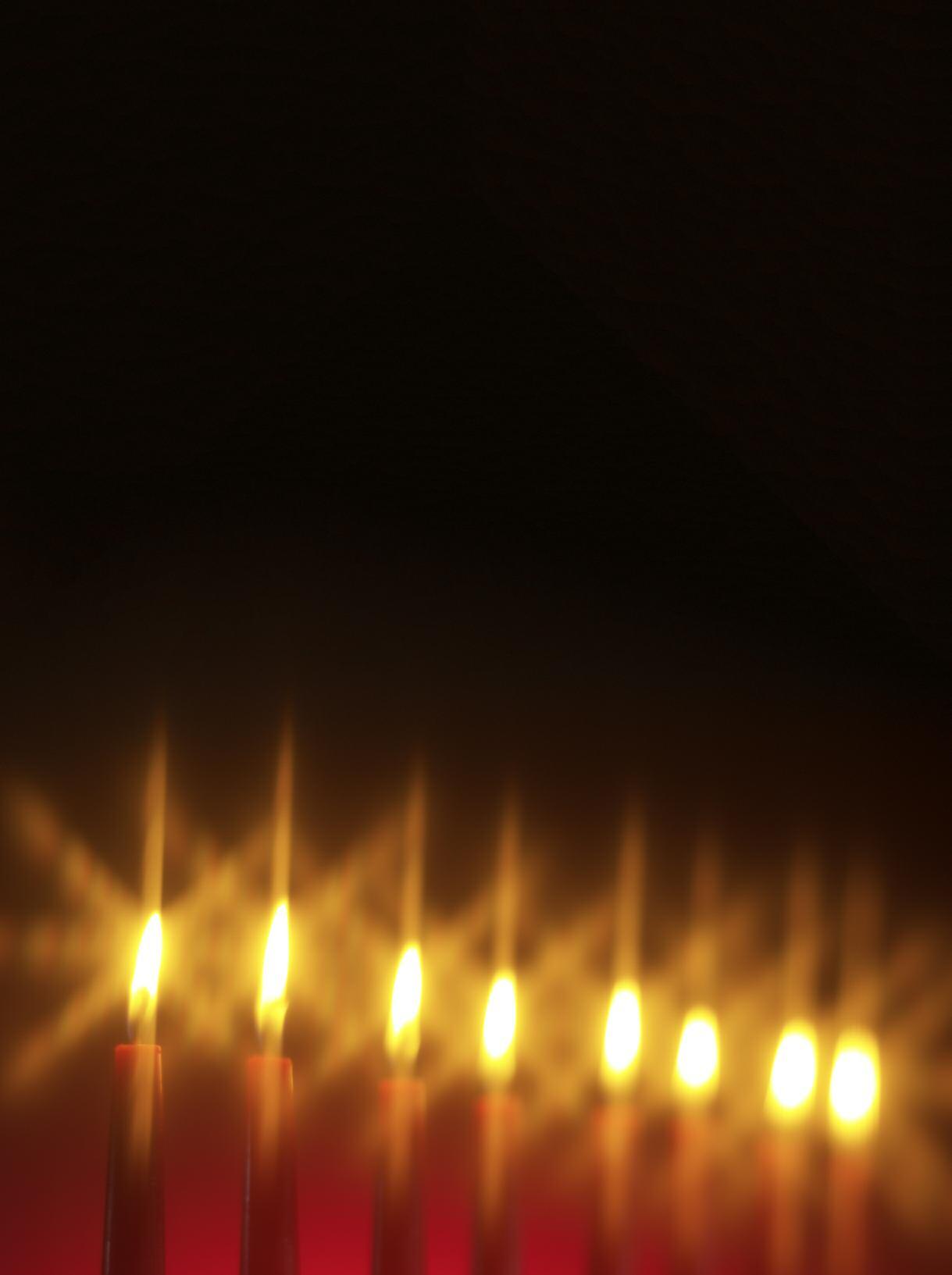
In the well-known maamar “Tanu Rabbanan – Ner Chanukah”, the Rebbe RaShaB, Rav Sholom DovBer of Lubavitch teaches: “G-d created [the universe in such a way that] each being has its opposite counterpart.”1 Each one of us was created with a Nefesh HaElokis, a G-dly soul, which possesses potential for G-dly intellect, emotion, thought, speech and action. In addition, we were all created with a Nefesh HaBahamis (animal soul) whose potentials stem from the sitra achra (the “other”, negative side).
Our lives can be simplified as a grand struggle for the G-dly soul to reign over the animal soul. For most of us, this is a lifelong battle. A tzaddik, however, is on a higher level – the level of repose. The tzaddik’s love and joy of G-dliness allows him to overcome his animal soul without difficulty and it becomes nullified on its own.
This concept can be applied to the Chanukah lights. The goal of the Greeks was to make the Jews “forget [G-d’s] Torah and violate the decrees
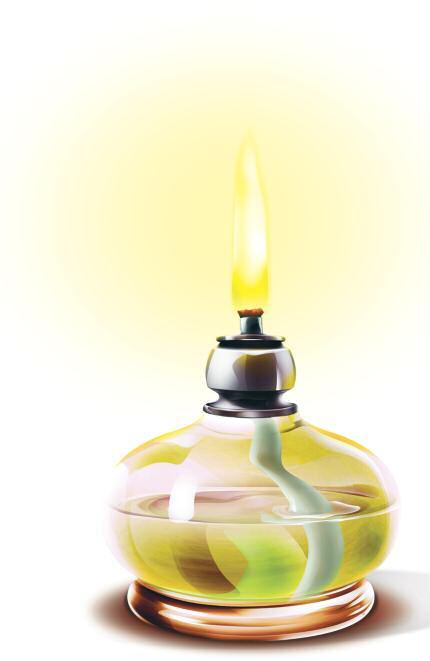
.
of [His] will.” They wanted the Jews to embrace the wisdom of kelipah (the shell that conceals the G-dly light in something), of the sitra achra. This is why the Greeks defiled the oil in the Beis HaMikdash. Oil is a common metaphor for wisdom. The Greeks did not destroy all of the oil so there was none available. They defiled it and made it unfit for use in the menorah. The objective was to bring in the wisdom of kelipah to make the holy wisdom of Torah impure.2 The Greeks wanted to divorce the Jewish people from G-d, saying, “Write on the horn of an ox [that you have no share in the G-d of Israel].”3
The Tanya (end of chapter 8) explains that unholy wisdom brings more severe impurity than the impurity brought by frivolous negative experiences. Frivolous experiences impact one’s middos (emotive attributes) which can be corrected by increasing in Torah 4 Negative wisdom, however, brings impurity to one’s intellectual qualities – Chochmah, Binah and Daas (wisdom, understanding and knowledge). These qualities are part of the core essence of the G-dly soul and damaging them with negative
wisdom can impart a much deeper impurity on the soul.
Pure Torah wisdom uplifts the soul and refines one’s characteristics, culminating in the ideal characteristic of being bitul (subservient) to Hashem. On the other hand, impure wisdom brings about the opposite – an increase in self-absorption (yeshus), which is contrary to the Torah.

The Greeks, representing the sitra achra, wanted to hold sway over the Jews and destroy the bitul of the Torah’s wisdom and replace it with the self-centered approach of secular philosophy. That is why the Maccabees, after their victory over the Greeks, declared that the Chanukah lights should be lit as a symbol of the “light” of “Torah”.5
Just as the Maccabees were victorious over the impure wisdom of the Greeks, we should all be blessed with great success in elevating our G-dly soul over the animal soul and placing Torah wisdom above all other philosophies. May the Jewish people achieve the success of the Maccabees and the dominion of Torah reign supreme with the immediate Redemption and revelation of Moshiach.
A hint of Chanukah can be found in the Torah in parshas Emor. After the Torah tells us about all of the YomimTovim, the Torah tells us ךילא וחקיו ךז תיז ןמש. Some say this is a reference to Chanukah.
The Gemara asks הכונח יאמ “What is Chanukah?” What is the Gemara’s question? Don’t we all know about the holiday of Chanukah? Rabbi Meir Schapiro answers that the Gemara means to ask, “What is the essence of Chanukah... What gives us the strength to fight the evil and our evil inclination?” The answer is the holy flames, the flames of Torah and mitzvos give us the strength to live according to Hashem’s will. There were many miracles that happened on Chanukah, so why did the Sages establish the holiday based on the miracle of oil? Because the other miracles, like winning the war and the many in the hands of the few, etc. could sometimes be mistaken for natural occurrences that just happened to work out in favor of the Jews. With the miracle of oil it was a clear miracle and everyone had to admit that Hashem made it happen.
EXCLUSIVELY KOSHER OBSERVANT JEWS WORLDWIDE:
5,500,000
3,500,000 keep kosher at certain times of the year, such as RoshHashanah and Pesach
USA
1,000,000+ keep kosher year-round.
There are aprox. 5,500,000 Jews in the USA.
Of the 6,000,000 Jews in Israel:
1,200,000 are Orthodox
yet over 4,000,000 Jews observe kashrus in Israel.
40%
of Jews observe kashrus
The largest Jewish population in Europe, has as many as 40% of its near 500,000 Jews observing kashrus.
Other countries with 10,000+ kosher observing Jews: UK, Argentina, Canada, Australia, Mexico, Brazil, and Russia.


